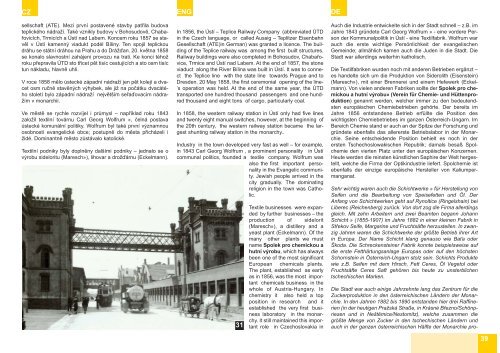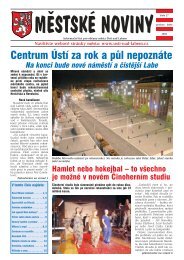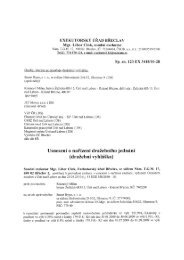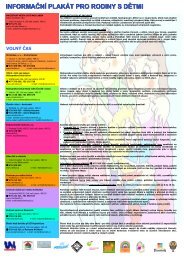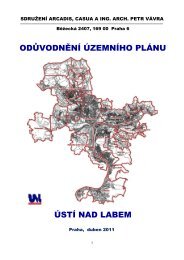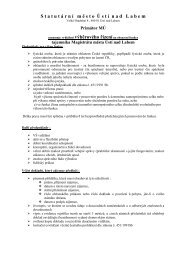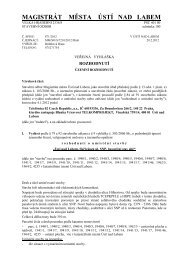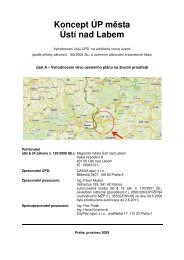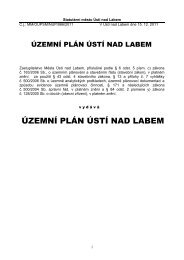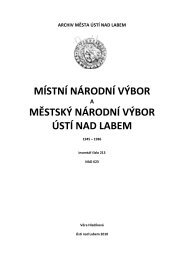Historie a památky města Ústí nad Labem History and monuments of ...
Historie a památky města Ústí nad Labem History and monuments of ...
Historie a památky města Ústí nad Labem History and monuments of ...
Sie wollen auch ein ePaper? Erhöhen Sie die Reichweite Ihrer Titel.
YUMPU macht aus Druck-PDFs automatisch weboptimierte ePaper, die Google liebt.
CZ ENG DE<br />
sellschaft (ATE). Mezi první postavené stavby patřila budova<br />
teplického nádraží. Také vznikly budovy v Bohosudově, Chabařovicích,<br />
Trmicích a <strong>Ústí</strong> <strong>nad</strong> <strong>Labem</strong>. Koncem roku 1857 se stavěl<br />
v <strong>Ústí</strong> kamenný viadukt podél Bíliny. Ten spojil teplickou<br />
dráhu se státní dráhou na Prahu a do Drážďan. 20. května 1858<br />
se konalo slavnostní zahájení provozu na trati. Ke konci téhož<br />
roku přepravila ÚTD sto třicet pět tisíc cestujících a sto osm tisíc<br />
tun nákladu, hlavně uhlí.<br />
V roce 1858 mělo ústecké západní nádraží jen pět kolejí a dvacet<br />
osm ručně stavěných výhybek, ale již na počátku dvacátého<br />
století bylo západní nádraží největším seřaďovacím nádražím<br />
v monarchii.<br />
Ve městě se rychle rozvíjel i průmysl – například roku 1843<br />
založil textilní továrnu Carl Georg Wolfrum », čelná postava<br />
ústecké komunální politiky. Wolfrum byl také první významnou<br />
osobností evangelické obce; postupně do <strong>města</strong> přicházeli i<br />
židé. Dominantně město zůstávalo katolické.<br />
Textilní podniky byly doplněny dalšími podniky – jednalo se o<br />
výrobu sideloritu (Maresch»), lihovar a drožďárnu (Eckelmann).<br />
In 1856, the <strong>Ústí</strong> – Teplice Railway Company (abbreviated ÚTD<br />
in the Czech language, or called Aussig – Teplitzer Eisenbahn<br />
Gesellschaft (ATE)in German) was granted a licence. The building<br />
<strong>of</strong> the Teplice railway was among the first built structures.<br />
Railway buildings were also completed in Bohosudov, Chabařovice,<br />
Trmice <strong>and</strong> <strong>Ústí</strong> <strong>nad</strong> <strong>Labem</strong>. At the end <strong>of</strong> 1857, the stone<br />
viaduct along the River Bílina was built in <strong>Ústí</strong>. It was to connect<br />
the Teplice line with the state line towards Prague <strong>and</strong> to<br />
Dresden. 20 May 1858, the first ceremonial opening <strong>of</strong> the line-<br />
’s operation was held. At the end <strong>of</strong> the same year, the ÚTD<br />
transported one hundred thous<strong>and</strong> passengers <strong>and</strong> one hundred<br />
thous<strong>and</strong> <strong>and</strong> eight tons <strong>of</strong> cargo, particularly coal.<br />
In 1858, the western railway station in <strong>Ústí</strong> only had five lines<br />
<strong>and</strong> twenty eight manual switches, however, at the beginning <strong>of</strong><br />
the 20th century, the western railway station became the largest<br />
shunting railway station in the monarchy..<br />
Industry in the town developed very fast as well – for example,<br />
in 1843 Carl Georg Wolfrum , a prominent personality in <strong>Ústí</strong><br />
communal politics, founded a textile company. Wolfrum was<br />
also the first important personality<br />
in the Evangelic community.<br />
Jewish people arrived in the<br />
city gradually. The dominating<br />
religion in the town was Catholic.<br />
31<br />
Textile businesses were exp<strong>and</strong>ed<br />
by further businesses – the<br />
production <strong>of</strong> sidelorit<br />
(Maresch»), a distillery <strong>and</strong> a<br />
yeast plant (Eckelmann). Of the<br />
many other plants we must<br />
name Spolek pro chemickou a<br />
hutní výrobu, which has always<br />
been one <strong>of</strong> the most significant<br />
European chemicals plants.<br />
The plant, established as early<br />
as in 1856, was the most important<br />
chemicals business in the<br />
whole <strong>of</strong> Austria-Hungary. In<br />
chemistry it also held a top<br />
position in research <strong>and</strong> it<br />
established the very first business<br />
laboratory in the monarchy.<br />
It still maintained this important<br />
role in Czechoslovakia in<br />
Auch die Industrie entwickelte sich in der Stadt schnell – z.B. im<br />
Jahre 1843 gründete Carl Georg Wolfrum » - eine vordere Person<br />
der Kommunalpolitik in <strong>Ústí</strong> - eine Textilfabrik. Wolfrum war<br />
auch die erste wichtige Persönlichkeit der evangelischen<br />
Gemeinde; allmählich kamen auch die Juden in die Stadt. Die<br />
Stadt war allerdings weiterhin katholisch.<br />
Die Textilfabriken wurden noch mit <strong>and</strong>eren Betrieben ergänzt –<br />
es h<strong>and</strong>elte sich um die Produktion von Siderolith (Eisenstein)<br />
(Maresch»), mit einer Brennerei und einem Hefewerk (Eckelmann).<br />
Von vielen <strong>and</strong>eren Fabriken sollte der Spolek pro chemickou<br />
a hutní výrobu» (Verein für Chemie- und Hüttenproduktion)<br />
genannt werden, welcher immer zu den bedeutendsten<br />
europäischen Chemiebetrieben gehörte. Der bereits im<br />
Jahre 1856 entst<strong>and</strong>ene Betrieb erfüllte die Position des<br />
wichtigsten Chemiebetriebes im ganzen Österreich-Ungarn. Im<br />
Bereich Chemie st<strong>and</strong> er auch an der Spitze der Forschung und<br />
gründete ebenfalls das allererste Betriebslabor in der Monarchie.<br />
Seine entscheidende Position behielt es noch in der<br />
ersten Tschechoslowakischen Republik; damals besaß Spolchemie<br />
den vierten Platz unter den europäischen Konzernen.<br />
Heute werden die reinsten künstlichen Saphire der Welt hergestellt,<br />
welche die Firma der Optikindustrie liefert. Spolchemie ist<br />
ebenfalls der einzige europäische Hersteller von Kaliumpermanganat.<br />
Sehr wichtig waren auch die Schichtwerke » für Herstellung von<br />
Seifen und die Bearbeitung von Speisefetten und Öl. Der<br />
Anfang von Schichtwerken geht auf Rynoltice (Ringelshain) bei<br />
Liberec (Reichenberg) zurück. Von dort zog die Firma allerdings<br />
gleich. Mit zehn Arbeitern und zwei Beamten begann Johann<br />
Schicht » (1855-1907) im Jahre 1882 in einer kleinen Fabrik in<br />
Střekov Seife, Margarine und Fruchtsäfte herzustellen. In zwanzig<br />
Jahren waren die Schichtwerke der größte Betrieb ihrer Art<br />
in Europa. Der Name Schicht klang genauso wie Baťa oder<br />
Škoda. Die Schreckensteiner Fabrik konnte beispielsweise auf<br />
die erste Fetthärtungsanlage Europas oder auf den höchsten<br />
Schornstein in Österreich-Ungarn stolz sein. Schichts Produkte<br />
wie z.B. Seifen mit dem Hirsch, Fett Ceres, Öl Vegetol oder<br />
Fruchtsäfte Ceres Saft gehören bis heute zu unsterblichen<br />
tschechischen Marken.<br />
Die Stadt war auch einige Jahrzehnte lang das Zentrum für die<br />
Zuckerproduktion in den österreichischen Ländern der Monarchie.<br />
In den Jahren 1882 bis 1890 entst<strong>and</strong>en hier drei Raffinerien<br />
(in der heutigen Pražská Straße, in Krásné Březno/Schönpriesen<br />
und in Neštěmice/Nestomitz), welche zusammen die<br />
größte Menge von Zucker in den tschechischen Ländern und<br />
auch in der ganzen österreichischen Hälfte der Monarchie pro-<br />
39


